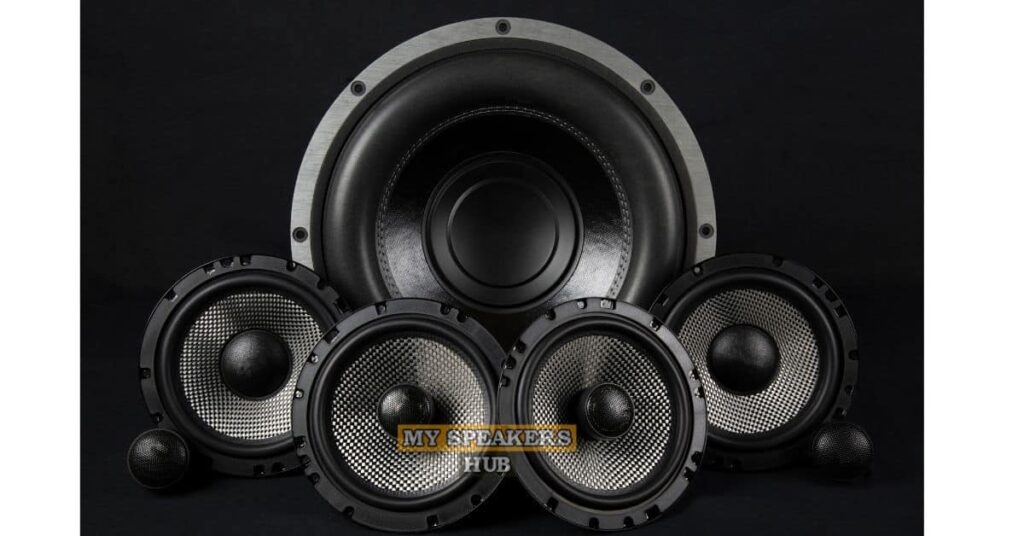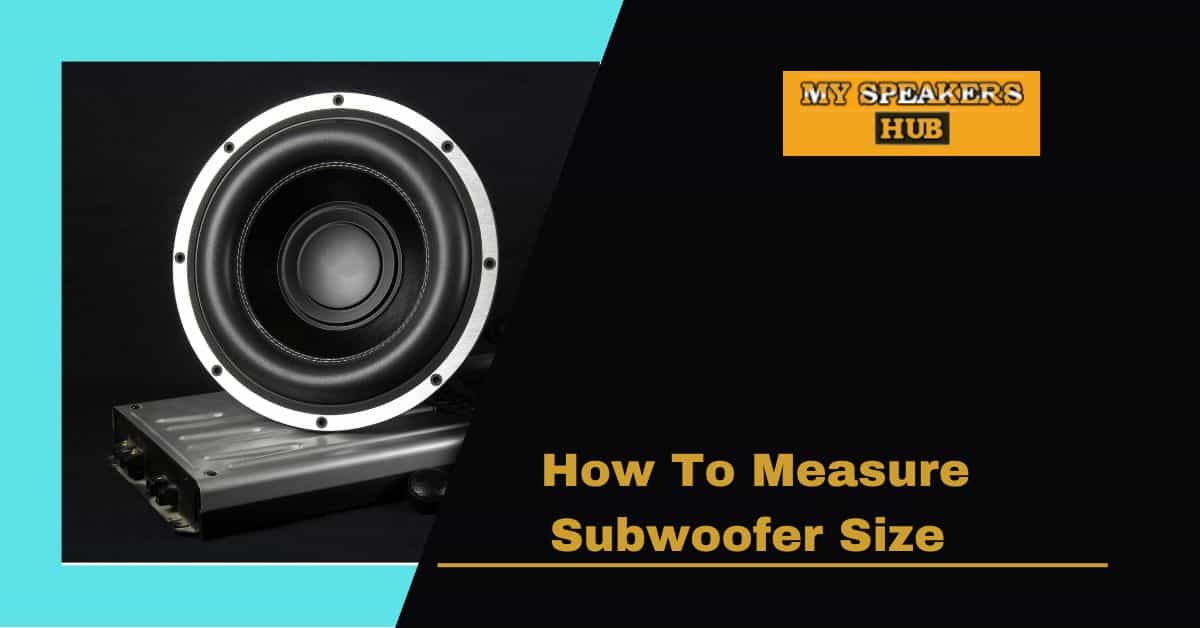Welcome to our guide on how to measure subwoofer size! Subwoofers are a great way to add depth and power to your audio system, but it can be difficult to know which size is right for your setup. In this guide, we’ll go over the different factors that come into play when selecting the right size subwoofer, and how to accurately measure the size you need. Read on to find out more!
What is a subwoofer and why is it important to measure the size
A subwoofer is a type of loudspeaker specifically designed to reproduce low-pitched audio frequencies, known as bass. It is typically larger than the other speakers in a home theatre system and produces sound at a much lower frequency than regular speakers. The size of a subwoofer is important to measure in order to determine the best sound quality and performance. The size of the subwoofer affects how much air it can move, and therefore how much bass it can produce. A larger subwoofer can move more air, which in turn will produce more bass and a better sound.
Additionally, a larger subwoofer can also handle higher sound pressure levels than a smaller one, allowing it to reproduce low frequencies more accurately. Measuring the size of the subwoofer is important to ensure the best sound quality and performance.
How to measure the size of a subwoofer
The size of a subwoofer is determined by the diameter of its speaker cone. To measure the size of a subwoofer, use a measuring tape to measure the diameter of the speaker cone from one outer edge to the other.
Different types of subwoofer sizes and their benefits
There are many types of subwoofer sizes available, and each size has its own unique benefits. Smaller subs are great for those who want a tight, punchy bass response, while larger subs are better for those who want powerful, deep bass.
The most common subwoofer sizes are 8-inch, 10-inch, 12-inch, and 15-inch. Each size has its own advantages and disadvantages depending on the environment and the type of music being played.
For example, 8-inch subwoofers are lightweight and easy to transport, making them ideal for mobile setups. They also have a tight low-end response, making them suitable for genres such as EDM, hip-hop, and pop. However, they may not be able to handle the low-end frequencies of rock and metal music.
10-inch subwoofers are a bit larger and heavier, and they’re more suitable for larger rooms. They produce more bass than 8-inch subs, so they’re better for genres like rock and metal. However, they may not be as tight as 8-inch subs.

12-inch subwoofers are the most popular size and are great for larger rooms and bass-heavy genres. They provide a powerful low-end response and can handle low-end frequencies better than 10-inch subs.
Finally, 15-inch subwoofers are the biggest and heaviest subwoofers available. They’re the best choice for those who want maximum bass response and can handle the deepest bass frequencies. They’re great for home theater systems and large venues.
Factors to consider when selecting the right size subwoofer
When selecting a subwoofer, there are many factors to consider. The most important factor is the size of the subwoofer. A subwoofer should be large enough to provide the desired sound output, but not too large that it overpowers the other speakers.
The size of the room is also important. If the room is small, a smaller subwoofer should be used, while a larger room may require a larger subwoofer. The type of content being played is a factor as well. If the content is bass-heavy, a larger subwoofer may be needed to properly reproduce the sound.
The power of the subwoofer is also important. A subwoofer with too much power can overpower the other speakers, resulting in a muddy sound. A subwoofer with too little power won’t be able to properly reproduce the sound.
The sensitivity rating of the subwoofer is also important, as this will determine how much power is needed to reach the desired sound level.
Finally, the placement of the subwoofer is important as well. If the subwoofer is placed in the wrong location, it may not be able to properly reproduce the sound. Subwoofers should be placed in a corner to maximize sound output.
By considering all of these factors, you can ensure that you select the right size subwoofer for your needs.
Common mistakes to avoid when measuring subwoofer size
Common mistakes to avoid when measuring subwoofer size include not taking into account the necessary airspace needed for the subwoofer, not accounting for the power handling of the sub, and not taking into account the efficiency of the subwoofer.
When measuring the size of a subwoofer, it is important to take into account the necessary airspace needed for the subwoofer. This airspace will be determined by the enclosure size and the type of subwoofer. A sealed enclosure will need less airspace than a ported enclosure, so this should be taken into account when selecting the size of the subwoofer.
Another important factor is the power handling of the sub. Too much power can damage the sub and lead to poor performance. Therefore, it is important to make sure the power handling of the sub and the amplifier are matched.
Finally, the efficiency of the subwoofer should be taken into account when selecting the size. The efficiency of the subwoofer will determine how much power is necessary for it to achieve its desired performance. If the efficiency is too low, then more power will be required, whereas if the efficiency is too high, then less power will be necessary. Therefore, it is important to select a subwoofer that has an efficiency that matches the amplifier and enclosure size.
Tips and tricks for measuring subwoofer size accurately
Measuring the size of a subwoofer accurately is important for ensuring the best performance for a sound system. Here are some tips and tricks for measuring subwoofer size accurately:
- Use a ruler or measuring tape: The easiest way to measure subwoofer size is to use a ruler or measuring tape. This will give you the most accurate measurement.
- Measure from the center of the subwoofer: When measuring the size of a subwoofer, make sure to measure from the center of the subwoofer in order to get an accurate measurement.
- Measure the height, width, and depth of the subwoofer: When measuring the size of a subwoofer, make sure to measure the height, width, and depth of the subwoofer. This will ensure that the size of the subwoofer is accurate.
- Subtract any extra packaging: When measuring the size of a subwoofer, make sure to subtract any extra packaging such as protective foam or plastic that may be around the subwoofer. This will ensure that you get an accurate measurement.
- Measure in two directions: When measuring the size of a subwoofer, make sure to measure in two directions. This will ensure that the measurements are accurate and that any discrepancies are accounted for.
- Take multiple measurements: To make sure that the measurements you take are accurate, it is a good idea to take multiple measurements and then average them out. This will ensure that you get the most accurate measurement.
Frequently Asked Questions[FAQs]
What is the difference between a subwoofer and a woofer?
A subwoofer is a type of speaker that is specifically designed to reproduce low-frequency sound, such as bass. It is usually larger in size than a woofer, which is designed to reproduce mid-range frequencies. Subwoofers typically range in size from 8 inches to 20 inches in diameter.
What is the ideal size for a subwoofer?
The ideal size for a subwoofer will depend on the size of the room it is being used in and the type of audio being reproduced. Generally speaking, larger subwoofers will produce more powerful bass, but they can be difficult to fit in smaller rooms.
What is the difference between a sealed and ported subwoofer?
A sealed subwoofer is a type of subwoofer that is enclosed in an airtight box. This type of subwoofer typically produces tight, punchy bass. A ported subwoofer is a type of subwoofer that is enclosed in a box that has an opening or port. This type of subwoofer typically produces deeper, more powerful bass.
How do I know if my subwoofer is the right size?
To determine if your subwoofer is the right size, you should measure the diameter of the cone, the depth of the cone, and the mounting depth. Additionally, you should also measure the weight of the subwoofer. If the measurements and weight are within the manufacturer’s specs, then the subwoofer is the right size.
What is the best way to position a subwoofer?
The best way to position a subwoofer is to place it at the center of the listening area. Additionally, it should also be placed away from walls, as this can cause the bass frequencies to become distorted.
How can I make sure my subwoofer is performing optimally?
To make sure your subwoofer is performing optimally, you should ensure that the settings on your amplifier or receiver are correctly adjusted. Additionally, you should also make sure the subwoofer is correctly positioned within the room.
Conclusion
After reading this article, you should now have a better understanding of how to measure a subwoofer size. You should also be aware of the benefits of having the right size subwoofer for your audio system. With the right size and placement, you can achieve the best sound quality and performance from your audio system. No matter what size you choose, you can be sure that you are getting the most out of your system.


